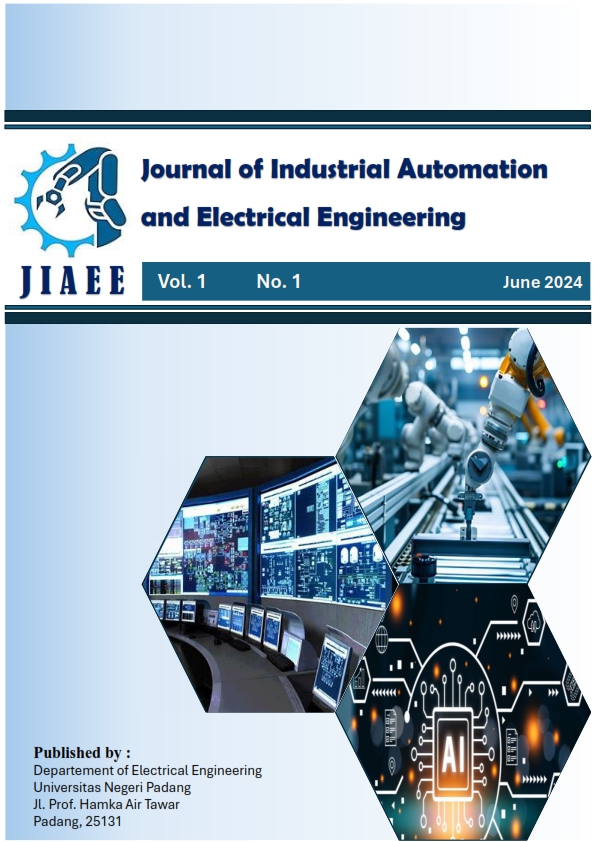Backpropagation neural network for DC-DC boost converter control using arduino microcontroller
Keywords:
DC-DC boost converter, Microcontroller , Artificial neural network, Backpropagation, Arduino Mega 2560Abstract
One kind of power converter that is frequently found in devices that employ a DC voltage source to produce a voltage output higher than the input voltage is the boost converter. The boost converter output voltage converter must be adjusted in order to produce the desired voltage output. This research suggests utilizing an Arduino Mega 2560 microcontroller implemented backpropagation-type artificial neural network to manage the boost converter output voltage. The highest output voltage of the boost converter is 24 volts, and its input voltage is 12 volts. Laboratory tests using different reference voltages and loads are used to validate the boost converter voltage control system based on a backpropagation neural network. Experiments conducted under a variety of test conditions demonstrate that the backpropagation neural network-based boost converter output voltage control system used in this study has effectively controlled the boost converter output voltage in accordance with the reference output voltage value, both when the load and the reference voltage are varied.
Downloads
References
[1] M. Z. Hossain, N. A. Rahim, and J. a/l Selvaraj, “Recent progress and development on power DC-DC converter topology, control, design and applications: A review,” Renewable and Sustainable Energy Reviews, vol. 81, no. January 2017, pp. 205–230, 2018, doi: 10.1016/j.rser.2017.07.017
[2] D. P. Mishra, R. Senapati, and S. R. Salkuti, “Comparison of DC-DC converters for solar power conversion system,” Indonesian Journal of Electrical Engineering and Computer Science, vol. 26, no. 2, pp. 648–655, 2022, doi: 10.11591/ijeecs.v26.i2.pp648-655.
[3] P. Azer and A. Emadi, "Generalized State Space Average Model for Multi-Phase Interleaved Buck, Boost and Buck-Boost DC-DC Converters: Transient, Steady-State and Switching Dynamics," IEEE Access, vol. 8, pp. 77735-77745, 2020, doi: 10.1109/ACCESS.2020.2987277.
[4] M. Yuhendri and R. Setiawan, “Implementasi DC-DC Boost Converter Menggunakan Arduino Berbasis Simulink Matlab,” JTEIN: Jurnal Teknik Elektro Indonesia, vol. 1, no. 2, pp. 144–149, 2020, doi: 10.24036/jtein.v1i2.64.
[5] Y. -C. Hsieh, T. -C. Hsueh and H. -C. Yen, "An Interleaved Boost Converter With Zero-Voltage Transition," IEEE Transactions on Power Electronics, vol. 24, no. 4, pp. 973-978, April 2009, doi: 10.1109/TPEL.2008.2010397.
[6] P. Peri and M. Yuhendri, “Kendali Tegangan Konverter Boost Berbasis Proposional Integral (PI),” Ranah Research : Journal of Multidisciplinary Research and Development, vol. 5, no. 1, pp. 7–15, 2022, doi: 10.38035/rrj.v5i1.564
[7] M. Yuhendri, I. Z. Candra, and C. Dewi, “Kendali Boost converter Berbasis Fuzzy sugeno,” JTEIN: Jurnal Teknik Elektro Indonesia, vol. 4, no. 1, pp. 50–59, 2023.
[8] Y. Koç, Y. Birbir, and H. Bodur, “Non-isolated high step-up DC/DC converters – An overview,” Alexandria Engineering Journal, vol. 61, no. 2, pp. 1091–1132, 2022, doi: 10.1016/j.aej.2021.06.071.
[9] Y. -S. Hwang, Y. -T. Ku, A. Liu, C. -H. Chen and J. -J. Chen, "A New Efficiency-Improvement Low-Ripple Charge-Pump Boost Converter Using Adaptive Slope Generator With Hysteresis Voltage Comparison Techniques," in IEEE Transactions on Very Large Scale Integration (VLSI) Systems, vol. 23, no. 5, pp. 935-943, May 2015, doi: 10.1109/TVLSI.2014.2331315.
[10] A. Alfaris and M. Yuhendri, “Sistem Kendali dan Monitoring Boost Converter Berbasis GUI (graphical user interface) Matlab Menggunakan Arduino,” JTEIN: Jurnal Teknik Elektro Indonesia, vol. 1, no. 2, pp. 266–272, 2020, doi: 10.24036/jtein.v1i2.83.
[11] M. Veerachary and P. Kumar, "Analysis and Design of Quasi-Z-Source Equivalent DC–DC Boost Converters," IEEE Transactions on Industry Applications, vol. 56, no. 6, pp. 6642-6656, Nov.-Dec. 2020, doi: 10.1109/TIA.2020.3021372.
[12] M. Veerachary, "Analysis of Minimum-Phase Fourth-Order Buck DC–DC Converter," IEEE Transactions on Industrial Electronics, vol. 63, no. 1, pp. 144-154, Jan. 2016, doi: 10.1109/TIE.2015.2472525.
[13] E. Ibarra, A. Arias, I. M. de Alegría, A. Otero and L. de Mallac, "Digital Control of Multiphase Series Capacitor Buck Converter Prototype for the Powering of HL-LHC Inner Triplet Magnets," IEEE Transactions on Industrial Electronics, vol. 69, no. 10, pp. 10014-10024, Oct. 2022, doi: 10.1109/TIE.2021.3120489.
[14] W. -L. Zeng et al., "A SAR-ADC-Assisted DC-DC Buck Converter With Fast Transient Recovery," IEEE Transactions on Circuits and Systems II: Express Briefs, vol. 67, no. 9, pp. 1669-1673, Sept. 2020, doi: 10.1109/TCSII.2020.3006274.
[15] A. Anggawan and M. Yuhendri, “Kendali Tegangan Output Buck Converter Menggunakan Arduino Berbasis Simulink Matlab,” JTEIN: Jurnal Teknik Elektro Indonesia, vol. 2, no. 1, pp. 34–39, 2021, doi: 10.24036/jtein.v2i1.110.
[16] S. R. Rex and D. M. M. S. R. Praba, “Design of PWM with four transistor comparator for DC–DC boost converters,” Microprocessors and Microsystems, vol. 72, 2020, doi: 10.1016/j.micpro.2019.07.003.
[17] N. V. Devarkar and A. Shiralkar, “Arduino based PWM DC-DC boost converter for traction system,” International Journal of Innovative Technology and Exploring Engineering, vol. 8, no. 11, pp. 3651–3653, 2019, doi: 10.35940/ijitee.K1790.0981119.
[18] M. Velani, K. Santoki, K. Khunt and S. Pedhadiya, "Simulation of Fuzzy Logic Controller for Boost Converter in Renewable Energy and HVDC Application," 2019 3rd International Conference on Recent Developments in Control, Automation & Power Engineering (RDCAPE), Noida, India, 2019, pp. 600-603, doi: 10.1109/RDCAPE47089.2019.8979127.
[19] P. Elisa, A. Hashinta, S. Riyadi, L. H. Pratomo, and F. B. Setiawan, “Analisa Kinerja Boost Converter dan Cascaded Boost Converter pada Kondisi Tidak Ideal,” Cyclotron, vol. 4, pp. 21–25, 2021.
[20] T. T. Arvianto, E. Wahjono, and I. Irianto, “Perancangan boost converter menggunakan kontrol proporsional integral (PI) sebagai suplai tegangan input inverter satu fasa untuk sistem uninterruptible power supply,” Tek. J. Sains dan Teknol., vol. 16, no. 2, p. 136, 2020, doi: 10.36055/tjst.v16i2.8511.
[21] A. Taheri, A. Ghasemian, and H. P. Ren, “Sliding mode control of Boost converter with jump flow switched system,” J. Franklin Inst., vol. 357, no. 18, pp. 13734–13752, 2020, doi: 10.1016/j.jfranklin.2020.10.022.
[22] N. F. N. Ismail, I. Musirin, R. Baharom and D. Johari, "Fuzzy logic controller on DC/DC boost converter," 2010 IEEE International Conference on Power and Energy, Kuala Lumpur, Malaysia, 2010, pp. 661-666, doi: 10.1109/PECON.2010.5697663.
[23] R. N. Raj, K. V. Purushothaman and N. A. Singh, "Adaptive TSK-type neural fuzzy controller for boost DC-DC converter," 2017 IEEE International Conference on Circuits and Systems (ICCS), Thiruvananthapuram, India, 2017, pp. 441-446, doi: 10.1109/ICCS1.2017.8326039
[24] B. S. Dhivya, V. Krishnan, and R. Ramaprabha, “Neural network controller for boost converter,” Proc. IEEE Int. Conf. Circuit, Power Comput. Technol. ICCPCT 2013, pp. 246–251, 2013, doi: 10.1109/ICCPCT.2013.6529052.
[25] S. -H. Kim, S. -H. Kim, H. -J. Byun, J. Yi and C. -Y. Won, "Interleaved DC-DC boost converter in DC distribution fault detection method using Artificial Neural Networks," 2021 24th International Conference on Electrical Machines and Systems (ICEMS), Gyeongju, Korea, Republic of, 2021, pp. 2318-2322, doi: 10.23919/ICEMS52562.2021.9634630.
[26] B. S. Dhivya, V. Krishnan and R. Ramaprabha, "Neural network controller for boost converter," 2013 International Conference on Circuits, Power and Computing Technologies (ICCPCT), Nagercoil, India, 2013, pp. 246-251, doi: 10.1109/ICCPCT.2013.6529052.
[27] R. Panahidoost, H. Mirshekali, R. Dashti, R. Samsami, M. H. Rezaei and H. R. Shaker, "Optimized Artificial Neural Network-Based Control Strategy For Boost Converters," 2022 International Conference on Electrical, Computer, Communications and Mechatronics Engineering (ICECCME), Maldives, Maldives, 2022, pp. 1-5, doi: 10.1109/ICECCME55909.2022.9987744.
[28] D. P. M D, A. C and M. G. Umamaheswari, "Design of Neural Network Based Controller for Switching Regulator in DC-DC Boost Converters," 2023 IEEE World Conference on Applied Intelligence and Computing (AIC), Sonbhadra, India, 2023, pp. 435-440, doi: 10.1109/AIC57670.2023.10263972.
[29] F. Timorremboko and O. T. Karya, “Implementasi Jaringan Syaraf Tiruan Pada Kendali Lampu Sorot Mobil Adaptif Berbasis Python,” J. Teknol. Elektro, vol. 11, no. 3, p. 142, 2020, doi: 10.22441/jte.2020.v11i3.006.
[30] G. Dewantoro and J. N. Sukamto, “Implementasi Kendali PID Menggunakan Jaringan Syaraf Tiruan Backpropagation,” Elkha, vol. 11, no. 1, p. 12, 2019, doi: 10.26418/elkha.v11i1.29959.
[31] R. Cahyadi et al., “Recurrent Neural Network (Rnn) Dengan Long Short Term Memory (Lstm) Untuk Analisis Sentimen Data Instagram,” J. Inform. dan Komput., vol. 5, no. 1, pp. 1–9, 2020.
[32] F. A. Hizham, Y. Nurdiansyah, and D. M. Firmansyah, “Implementasi Metode Backpropagation Neural Network (BNN) dalam Sistem Klasifikasi Ketepatan Waktu Kelulusan Mahasiswa (Studi Kasus: Program Studi Sistem Informasi Universitas Jember),” Berk. Sainstek, vol. 6, no. 2, p. 97, 2018, doi: 10.19184/bst.v6i2.9254.
[33] A. Rahim, K. Kusrini, and E. T. Luthfi, “Convolutional Neural Network untuk Kalasifikasi Penggunaan Masker,” Inspir. J. Teknol. Inf. dan Komun., vol. 10, no. 2, p. 109, 2020, doi: 10.35585/inspir.v10i2.2569.







